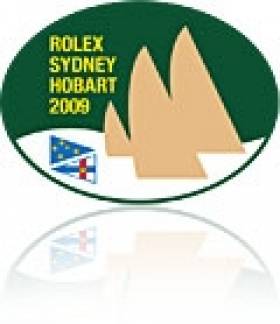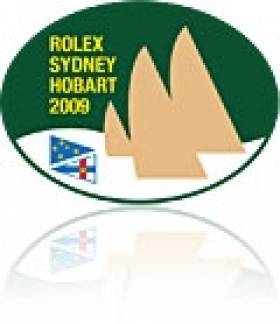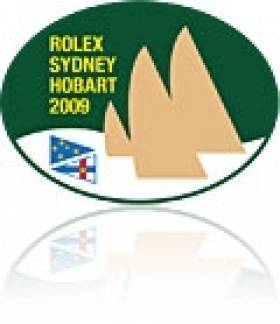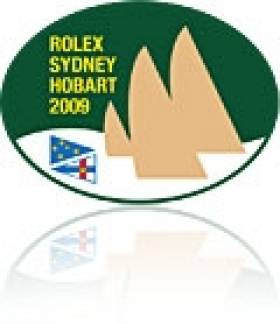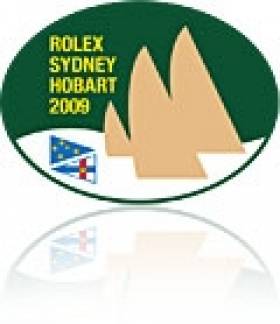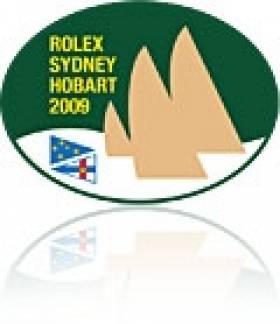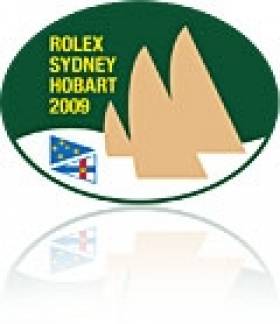Displaying items by tag: Sydney Hobart
Sydney–Hobart Sailors Prepared for 'The Great Race'
The 628 nautical mile Rolex Sydney Hobart Yacht Race is the most challenging offshore race in the world and is affectionately known among the sailing fraternity as ‘The Great Race’. With the current forecasted weather conditions, the 2015 edition promises to keep the myth intact and deliver one of the most challenging editions of the race in history.
As navigators and meteorologists pour over the weather data, it remains to be seen however, if it will be a big boat or a small boat race. But one thing is certain, the 109 boats entered can expect strong conditions: after the race starts on December 26, Southerly winds of 20-30 knots are predicted, with winds gusting well over 40 knots further down the track in the notorious Bass Strait. Strong winds will favor the larger yachts, but it’s important to keep in mind this is a handicap race, so it truly could be anyone’s race to win.
Commenting on their odds to win the race again this year, Roger Hickman, owner of Wild Rose, 2014 overall winner, said: “It’s hard to predict if we will be lucky enough to win again. It’s a long shot, but we are certainly allowed to dream. With these magnificent super yachts, the bigger boats such as Rambler 88 and so on, they are so fast - they will be days ahead of us, with so much daylight in between us.”
George David, owner of Rambler 88 built his Juan Kouyoumidjian-designed yacht expressly with a vision to compete in the Rolex Sydney Hobart. While this is David’s first time competing in the race, he has assembled an extremely experienced offshore crew, including navigator Andrew Cape who who’s taken part in 15 previous editions.
“We have spent a lot of time on the reliability of our systems, raced close to 7,000 nautical miles and focused on preparation. Following on from our lessons learned with Rambler 100 in the 2011 Rolex Fastnet Race, I think we emphasise safety more than any boat on the race course,” said David.
Rambler 88 also has world-renowned tactician Brad Butterworth (NZL) onboard who is competing in the race for the first time since the fateful 1998 edition when he won line honours onboard Larry Ellison’s Sayonara and a gust of 72 knots blew the wind gear off the mast. “This race has always been extreme. It’s the toughest race in the world. We have to be careful to get the boat all the way to Hobart in one piece, but race it hard.”
Meanwhile there is Comanche, cited by some as the “fastest monohull on earth”, which has returned again this year to Sydney with hopes of taking the prize for line honours, a battle they will have with local favourite, current record holder and eight-time line honours winner, Wild Oats IX.
Australian Jimmy Spithill, America’s Cup winner and 2014 ISAF Rolex World Sailor of the Year, has joined the American team; “I first sailed on Comanche in last year’s Rolex Sydney Hobart Race. Jim and Kristy (Clark) have assembled an awesome team with Kenny (Read) skippering, it really is one of the best offshore sailing teams in the world. This race is iconic in Australia and always been a dream of mine to win. This is looking like the most competitive race to date, with a number of big boats capable of winning and as always in ocean racing you never know what mother nature is going to dish up for you!”
As Matt Allen, owner of Ichi Ban (winner of the 1983 edition) and President of Yachting Australia remarked at today’s press conference; “It takes a long time to win this race. It’s a true boat and crew management exercise.”
Hundreds of thousands of spectators are expected to line the shores of Sydney Harbour on Boxing Day to watch the spectacular start of the 71st edition of ‘The Great Race’.
Ireland Hit The High Spot In The Sydney Hobart Race 23 Years Ago
#rshyr – Ireland's fascination with the Rolex Sydney-Hobart Race moved onto a new plane in 1991, when a three-boat Irish team team of all the talents had a runaway win in the Southern Cross Series which culminated with the 628-mile race to Hobart. The three skipper/helmsmen who led the squad to this famous victory twenty-three years ago were Harold Cudmore, Joe English and Gordon Maguire, all on top of their game.
These days, the incomparable Harold Cudmore is still a sailing legend, though mostly renowned now for his exceptional ability to get maximum performance out of large classics such as the 19 Metre Mariquita, sailing mainly in European waters.
But sadly, Joe English passed away just eight weeks ago in November in Cork, much mourned by many friends worldwide. Yet for Gordon Maguire, the experience of sailing at the top level in Australia was life-changing. He took to Australia in a big way, and Australia took to him as he built a professional sailing career. And he's still at it in the offshore racing game as keenly as ever, with 19 Sydney-Hobarts now logged, including two overall wins.
He raced the challenging course of this 70th 2014 edition as sailing master of the Carkeek 60 Ichi Ban, a boat which is still only 15 months old, having made a promising though not stellar debut in 2013's race. Also making a determined challenge was the First 40 Breakthrough with a strong Irish element in the crew led by Barry Hurley, fresh from the class win and second overall in October's Rolex Midde Sea Race.
And high profile Irish interest was also to be found aboard the Botin 65 Caro, the record breaker in the 2013 ARC Transatlantic Race. She's a very advanced German-built "racer/cruiser" aboard which Ian Moore - originally of Carrickfergus but longtime Solent-side resident - was sailing as navigator.
W M Nixon casts an eye back over the 2014 race, whose prize-giving took place in Hobart yesterday, and then concludes by taking us back to 1991, when Ireland moved top of the league in the Offshore Racing World Team Championship on the same occasion some 23 years ago.
It has to have been the most keenly-anticipated debut in recent world sailing at the top level. At last we'd get to see how Comanche could go in serious sailing. When the 70th 628-mile Rolex Sydney-Hobart Race started on Friday December 26th at 0200 hours our time, 1300 hrs local time in Sydney Harbour, this was for real. There may have been 117 boats of all shapes and sizes from 33ft to 100ft in the fleet. But all eyes were on the limit-pushing 100ft Comanche, skippered by the great Kenny Read. The world wanted to see how she would show what she could do when the chips were down, when the racing was straight line stuff, and when some serious offshore battling was in prospect instead of the inshore-hopping mini-test which had been seen in the Solas Big Boat Challenge in Sydney Harbour on December 9th.
In that, the well-tested Wild Oats XI, skippered by Mark Richards, had sailed a canny race to take the line honours win from the other hundred footers. But the majestic Comanche, owned by Jim Clark and his Australian wife Kristy Hinze Clark, had shown enough bursts of speed potential to raise the temperature as the start of the big one itself approached.
And in a brisk southerly at the start, Comanche didn't disappoint. She just zapped away from Wild Oats to lead by a clear 30 seconds and notch a record time at the first turning mark to take the fleet out of Sydney Harbour, and that dream debut was what made the instant headlines on the beginning of the 628–mile slog to Hobart.
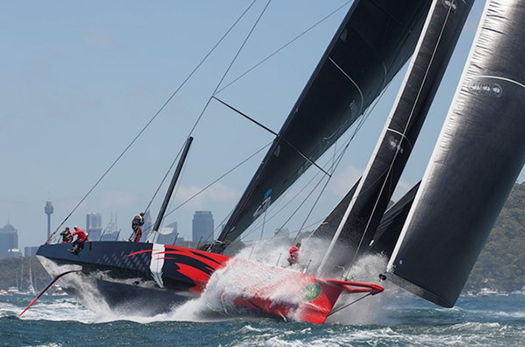
The moment of glory – the mighty Comanche roaring down Sydney Hobart at the start to log a record time to the first turning mark. Photo: Rolex/Daniel Forster
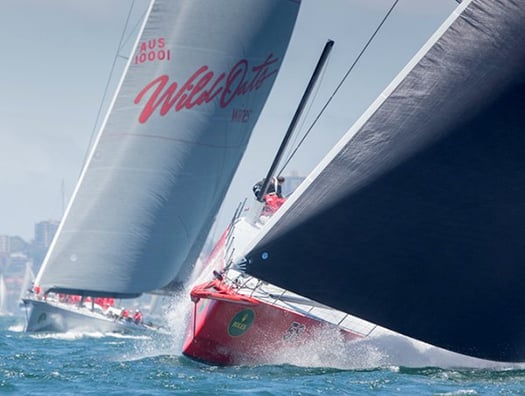
No two ways about it – Comanche is clear ahead of Wild Oats XI approaching the first mark. Photo: Rolex/Daniel Forster
But out at sea, with winds strengths varying but mostly from the south for the first day or so, different stories begin to emerge. A grand sunny southerly sailing breeze may provide lovely sailing and pure spectacle in Sydney Harbour. But get out into the Tasman Sea to head south for Hobart, and you find that the wayward south-going current – always a crucial factor in the early stages of the race to Hobart – can be going great guns and making mischief as a weather-going stream, kicking up a steep sea which can be boat-breaking when that last ounce of performance is being squeezed out.
And as previewed here on December 20th, up among the hundred-footers they've been pushing the envelope and then some in boat development and modification. In new boat terms, the mighty and notably beamy Comanche has gone about as far as they can go for now. But with the likes of the former Lahana reappearing as Rio 100 with a complete new rear half, and Syd Fischer's Ragamuffin 100 simply cutting away the hull for replacement with a complete new body unit while retaining the proven deck and rig, we're sailing right on the edge in terms of what the weird mixtures of new and old build can combine for combat when the seas are steep.
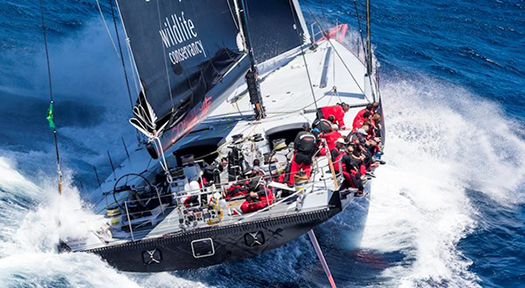
Comanche's wide beam gives added power when there's plenty of breeze......Photo: Rolex/Carlo Borlenghi
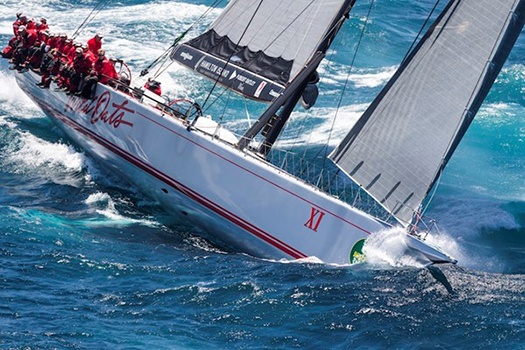
....but the narrow Wild Oats XI can be as slippery as an eel when the head seas get awkward, and when the wind eased she got through Comanche and into an extraordinary 40 mile lead on the water. Photo: Rolex/Carlo Borlenghi
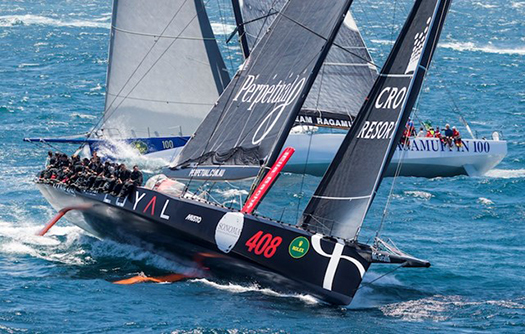
Not all boats revelled in the bone-shaking conditions of the first hundred miles of beating. Perpetual Loyal (foreground) had to pull out with hull damage possibly caused by an object in the water, but the irrepressible Syd Fischer's Ragamuffin 100 (beyond), with a completely new hull, continued going strong to the finish and was third in line honours Photo: Rolex/Carlo Borlenghi
But this glorious element of larger-than-life characters with boats that are off-the-wall is now an integral part of the RSHYR, which manages to attract an enormous amount of attention thanks to its placing in the midst of the dead of winter in the Northern Hemisphere, while in Australia much attention focuses on what is in effect an entire and familiar maritime community racing annually for the overall handicap prize.
Yet though the course is simple, it's deceptively so. Just because it's mainly a straight line from one harbour to another doesn't mean there aren't a zillion factors in play. And as the race gets so much attention, few offshore events of this length are so minutely analysed, and the first 24 hours provided a veritable laboratory for seeing the ways different boats behave in different wind and sea states with the breeze on the nose.
Thus Wild Oats XI has always had a formidable reputation for wiggling her exceptionally narrow hull to windward in awkward seas for all the world like a giant eel, and the early beating saw her doing that very thing, hanging in there neck and neck with Comanche. Despite her beamier hull, Comanche rates slightly lower than Wild Oats. But if a lull with its leftover sea arrived, her greater volume would become a liability to performance, whereas if the breeze got back to full strength, and particularly if it freed the two leaders, then Comanche would be firmly back in business.
But it was not be. Crossing the Bass Strait with Wild Oats right beside them, Comanche's crew saw their navigator Stan Honey emerge on deck and approach Kenny Read with a thoughtful expression on his face, and an ominous little slip of paper in his hand. It was the latest weather print-out, and it wasn't happy reading for a big wide boat that needs power in the breeze. Before expected brisk winds from the north set in, they'd to get through the lighter winds of an unexpectedly large and developing ridge.
Almost while they were still digesting this bit of bad news, Wild Oats started to cope much better with the lumpy leftover sea, and wriggled ahead of Comanche in her classic style. And the further she got ahead, the sooner she got into increasingly favourable wind pressure. As Read put it after the finish: "For twelve hours, conditions were perfect for Wild Oats, and they played a brilliant hand brilliantly".
Amazingly, the old Australian silver arrow opened out a clear lead of an incredible forty miles before conditions started to suit Comanche enough to start nibbling at this remarkable new margin. And fair play to the Read crew, at the finish they'd made such a comeback that Wild Oats was only something like 49 minutes ahead. But even with the new American boat's slightly lower rating, she was beaten on handicap too, and in the final rankings Wild Oats showed up as having line honours overall and a commendable 5th on IRC in Division 0 - and we shouldn't forget she won the overall handicap honours back in 2012 anyway.
But for 2014's race, for a while it looked as if it might be the Cookson 50s again for the overall win. But although last year's Tattersall's Cup winner, the Cookson 50 Victoire, at first took the Division 0 win with her sister-ship Pretty Fly III second, they were so close that when Pretty Fly got 13 minutes redress for an incident with the Ker 46 Patrice in mid-race, it reversed their placings.

It all came good in the end....after being initially placed second in Division 0, the ten-year-old Cookson 50 Pretty Fly III got 13 minutes of redress for an adverse incident during the race, and that bumped her up to the Division 0 win.
Either way, it was still Cookson 50s imprinted all over the sharp end of Division 0. But they were slipping in the overall rankings, where it was boats in the 40-45ft range which were settling into the best combination of timing and conditions to take the Tattersall's.
And plumb in the middle of them was the First 40 Breakthrough, with her strong Dublin Bay Sailing Club input from the Irish team led by Barry Hurley. Fortunes wax and wane with astonishing volatility as the Hobart race progresses, but gradually a pattern emerges. So though at one stage Breakthrough was showing up only around 30th overall, equally she'd a best show of third.
And all around her on the water were similarly-sized and similarly-rated boats with their race-hardened crews knowing that with every mile sailed and every weather forecast now fallen favourably into place, things were looking better and better for this group to provide the overall winner.
It was a very race-hardened crew which came out on top. It was way back in 1993 that Roger Hickman got his first Sydney Hobart Race overall win in an eight year old Farr 43 which was still called Wild Oats, as original owner Bob Oatley hadn't yet reclaimed the name for ever bigger Grand Prix racers. When he did start to go down that road, the 1985 Wild Oats became Wild Rose, but "Hicko" still owns her. And by the time the Rolex Sydney-Hobart Race 2014 started, he was doing it for the 38th time. He went into it as current Australian Offshore Champion, now he has won the big one on top of all that. Some man, some boat.
The slightly higher-rated Breakthrough was pacing with Wild Oats for much of the race, but as Barry Hurley's report for Afloat.ie told us with brutal honesty, somewhere some time they got off the pace. If you didn't know already of Barry's remarkable achievements - which include a class win in the single-handed Transatlantic Race and the more recent Middle Sea Race success – you would warm to the man anyway for the frankness of his initial analysis of why Breakthrough slipped from being a contender to 12th overall and – more painfully – down to 7th in their class of IRC Division 3.
He promises us more detailed thoughts on it in a few weeks time, something which will be of real value to everyone who races offshore, for the race to Hobart is a superb performance laboratory. And maybe we can also hope in due course for further thoughts from someone on whether or not Matt Allen's Carkeek 60 Ichi Ban, skippered by Gordon Maguire with Adrienne Cahalan as navigator, has what it takes to be a killer.
It's easy for us here in Ireland to look at screens of photos and figures and reckon that Ichi Ban is just a little bit too plump for her own good. But Maguire has twice been key to a Sydney-Hobart overall win, the most recent being in 2011 with Stephen Ainsworth's Loki. And Cahalan's record of success as a navigator/tactician is almost without parallel. Yet though Ichi Ban's 2014 Hobart race score of 8th in line honours and fourth in IRC Division 0 is a thoroughly competent result, it just lacks that little bit of stardust.
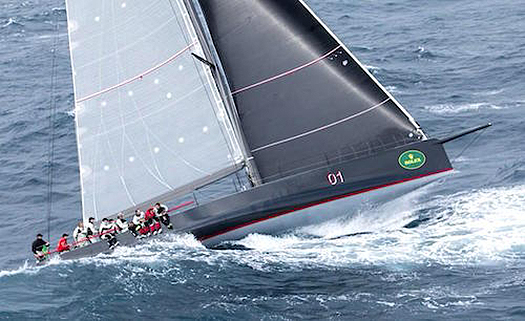
Ichi Ban finding her way through the waves on her way to Hobart. If that's not a spare tyre around her midriff, then what is it?
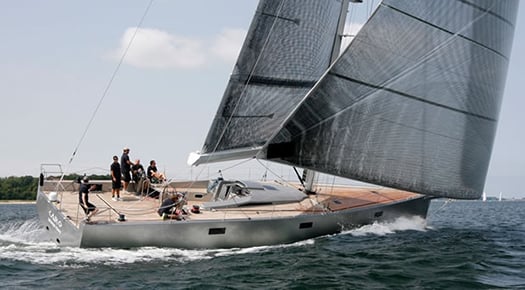
Despite being a "racer/cruiser", the Botin 65 Caro – navigated by Ian Moore – pipped Ichi Ban for third in class.
With the next Rolex Sydney-Hobart Race just over eleven months down the line, let's hope we're proven utterly wrong within the year on the Ichi Ban question. But the whole matter is pointed up by the fact that the boat which pipped in ahead of her in the IRC Div 0 placings in third place behind the two Cookson 50s was the Botin 65 Caro, with our own own Ian Moore navigating on this 65 footer which likes to emphasize her dual role as a racer-cruiser.
Now there really is food for thought. But in this first weekend of this wonderful new year of 2015, let's remember some of the events of December 1991 as recorded in excited detail in the Afloat magazine of Feb/March 1992.
On the cover is Meath-born John Storey's Sydney-based Farr 44 Atara, around which the Irish Southern Cross team of 1991 was built, as Harold Cudmore was aboard, and he brought out John Mulcahy from Kinsale and John Murphy from Crosshaven.
The small boat of the team was Tony Dunne's Davidson 36 Extension – the owner claimed Irishness through the Irish granny rule, but the matter was put beyond any doubt by Joe English being on board with Dan O'Grady and Conor O'Neill. And then for the third boat they'd Warren John's Davidson 40 Beyond Thunderdome, whose owner was happy to be Irish if they'd let him, and to put the matter beyond doubt his vessel was over-run by Howth men in the form of Gordon Maguire, Kieran Jameson, and Roger Cagney, with Dun Laoghaire's Mike O'Donnell allowed on board too, provided he behaved himself.

In the Southern Cross Series of 1991, the Davidson 40 Beyond Thunderdome was raced for Ireland by Gordon Maguire and Kieran Jameson. Thunderdome was top of the points table when she was knocked out with a dismasting in the final inshore race, and was unable to race to Hobart.
It was an accident-prone series, with Beyond Thunderdome dismasted in a tacking collision with one of the Australian boats with just three days to go to the start of the Hobart Race. There simply wasn't time to get a replacement mast, let alone tune it, but at the last minute the jury decided the Australian boat was at fault, and allowed Beyond Thunderdome average points not only for that race in which she'd been dismasted, but also for the Hobart Race which hadn't even yet been sailed.
In a final marvellous twist to the story, as Thunderdome couldn't race to Hobart, Gordon Maguire was drafted aboard Atara to add helming strength for the big one. Atara had only been a so-so performer until the big race. But Cudmore and Maguire – that really was the dream team. And it gave the dream result. Atara won the 1991 Sydney-Hobart race overall by a margin of one minute and 50 seconds. It was one of the closest results ever, but it was a close shave in the right direction for Ireland. The Irish party in Hobart to welcome 1992 was epic. And Gordon Maguire's sailing career was set on a stellar course.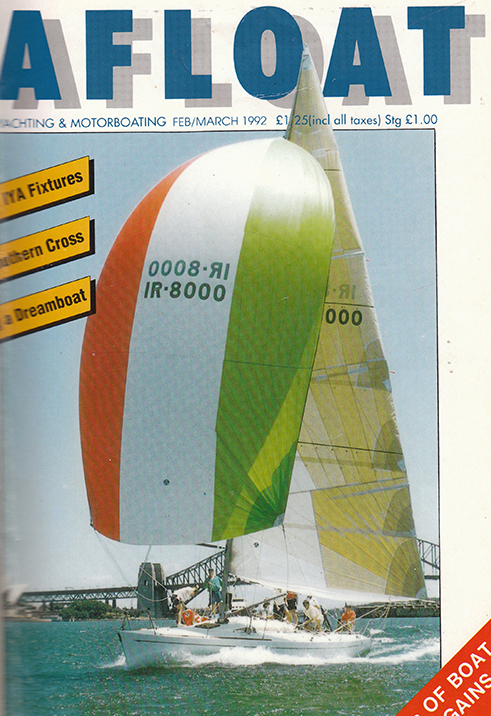
Our magazine edition of February/March 1992 cover-featured John Storey's Farr 44 Atara, overall winner of the 1991 Sydney-Hobart race with the dream team of Harold Cudmore and Gordon Maguire on board to give Ireland the win in the Southern Cross Series.
More Mast Woes Knocks Wedgetail Out of Sydney-Hobart For Second Time
#rshyr – A very disappointed Bill Wild has retired his Reichel/Pugh 55, Wedgetail, from the Sydney Hobart race after suffering mast damage in the Cruising Yacht Club of Australia's 628 nautical mile race at approximately 7.40pm off Schouten Island. All are safe and well on board. The yacht is motoring to Schouten Passage.
In last year's Rolex Sydney Hobart, Wedgetail, from Queensland, was dismasted in a south-west gale east of Tasman Island in the early hours of December 29; this time it was the hard running conditions that took their toll.
Last year not forgotten by the crew, sailing master Kevin Costin said prior to this race, "We're checking everything, and checking it twice; dotting our 'Is' and crossing our 'Ts'."
Eleven yachts have retired from the race to-date, and with Wild Oats XI taking her record eighth line honours victory and Comanche finishing a short time later, 104 yachts remain at sea.
The next three yachts expected to finish are the two supermaxis, Manouch Moshayedi's RIO 100 (US), Syd Fischer's Ragamuffin 100 along with Peter Harburg's VOR70, Black Jack – and not necessarily in that order. Ragamuffin 100 has been taking miles out of her US counterpart and may beat her to the punch. The trio is expected around 10.30pm, provided the breeze in the Derwent does not shut down on them.
Irish 'Breakthrough' Crew Fall Back in Sydney–Hobart Race
#rshyr – A joint Dublin Bay/Sydney crew are battling in strong winds to recover their mid–race third overall position after losing 22 places and first in division over the past 24 hours of the 628–mile Sydney–Hobart race.
The drop in performance – an estimated 1.5 knots off the pace all day – has prompted some of Breakthrough's shore crew to speculate that a torn spinnaker might be to blame.
Alternatively the easterly course chosen by Breakthrough might have contributed to a slower wind angle but for now there is no onboard report to explain the speed dip.
North-east winds are gusting up to 35 knots on the race course. A number of yachts have suffered damage including the dismasting of the Volvo 70, Giacomo.
The Barry Hurley led Breakthrough crew, that includes Dublin Bay sailors Kenneth and Alexander Rumball and Catherine Halpin, have slipped from third overall yesterday to 25th this morning with 200–miles left to the Hobart finish. The on–the–water race leaders have already finished in Hobart, Wild Oats XI took a record eighth win.
Just 24 hours earlier, as Breakhrough lay 33 miles off Gabo Island, the Irish crew were vying for the overall lead in the 70th edition of the race.
The slippage started last night around 11pm Irish time when the official standings revealed a drop to seventh overall. Hurley's crew maintained their class three lead despite being 1.5 knots off the pace but this morning – some ten hours later – the Beneteau First 40 crew has tumbled to 25th and is now tenth overall in a highly competitive 21–boat class three.
More on the race site here
Wild Oats XI Takes Record Eighth Sydney–Hobart Win
#rshyr – Wild Oats XI has secured a record eighth line honours victory in Australia's Sydney–Hobart Race.
"This is the sweetest victory by far," Wild Oats XI skipper Mark Richards declared today after steering the silver-grey thoroughbred to the historic win.
"To rewrite a bit of sailing history doesn't come along every day. To win a Hobart is a great honour but to win an eighth; I can't believe I am here," Richards said.
"It's been the hardest win," owner Bob Oatley added. "Comanche is an exceptional yacht, probably the most expensive yacht ever built. A wonderful boat. When she took off at the start of the race I was amazed."
"Comanche was unbelievably impressive down Sydney Harbour," Richards said, "and the whole first night she had the legs on us. We thought, 'how are we going to handle this thing'?
"It was definitely our toughest race. To have a boat so close for so much of the race, especially when she's faster than you. I said to the guys 'we've got to hang in there, hang tough, minimise our losses and wait for the first opportunity we get to attack'.
The break came on Saturday morning in the middle of Bass Strait. Gone were the fresh conditions of the first day, ahead loomed a ridge of high pressure sweeping between the mainland and Tasmania; a wall of light air that would define the 2014 Rolex Sydney Hobart.
Get through the gate in time and there would be a light breeze, but a breeze nevertheless. Get caught on the wrong side and face a purgatory of calm. Wild Oats XImade the closing gate and, at last, found the lighter conditions that so suited her. She steadily pulled away from Comanche, opening up a 40 mile lead.
"It was a race to get through that gate from three days before the race," when the Bureau of Meteorology warned the competing crews of the looming ridge at the pre-race briefing at the Cruising Yacht Club of Australia, said Wild Oats XI's tactician Iain Murray.
"Luckily for us, we just got through the gate. Comanche got there too, but they were slow out of it. We did really well to hang onto them in the rough stuff and still be side by side with her on Saturday morning, and then it was our turn."
"It was a race to get past the ridge," Richards agreed, 'that was the whole thing. They actually slowed us down in the light weather. We went to leeward of them, but couldn't get past, so we ended up taking a big pill, lost some ground to get to weather of them. But eventually it paid off, we got past them and away we went."
The nine year-old slim Wild Oats XI, designed by Reichel/Pugh and built by McConaghy, is faster in light airs than the more powerful wider and heavier Comanche.
Oatley's yacht was in her element in Bass Strait. But as the winds built up again this morning, the balance swung back in favour of the big American. As the pair raced down the Tasmanian coast she gradually reeled Oats back in. But with lighter air forecast in Storm Bay, Richards remained confident.
"It was inevitable that they would gain on us," Richards said, "but we knew that once they got us they wouldn't get past us. We finished in our perfect conditions."
So is it official now? Is Wild Oats XI one of the greatest Sydney Hobart yachts of all time, alongside the likes of Solo,Astor, Kurrewa IV, Kialoa and Condor of Bermuda?
"Just look at the record," Richards beamed, "she'll go down as one of the legends of the race."
Can she stay at the top? Every year there have been major innovations made to the boat to keep her competitive. Are there more modifications to the 10-year-old boat to come?
"She always needs something," Bob Oatley laughs, "she is a very expensive girl to look after."
"There's not a lot left we can do to this boat other than to sail it well," Iain Murray says. "It is a great all-round boat. Clearly it has an advantage over the newer boats in light winds and it's up to us to sail the boat in stronger winds as best we can and minimise the damage."
Follow the race on the live tracker here.
Perpetual Loyal Hits 'Something', Retires From Sydney–Hobart Yacht Race
#rshyr – One of the super maxis vying for line honours in the Rolex Sydney Hobart Yacht Race, Anthony Bell's Perpetual Loyal, has retired and is returning to her home club at Rose Bay in Sydney.
The crew believes the yacht may have hit something at about 9 pm last night (2100 AEDT), the hull started delaminating and the yacht took on water in the bow.
The crew is safe and expected to arrive at port in about 24 hours.
The extent of the damage will not be known until the yacht is out of the water.
Understandably, the crew is "devastated".
Perpetual Loyal advised the Cruising Yacht Club of Australia it was retiring with hull damage just after 0800 AEDT today when she was east of Eden.
Broken rudders, sail and hull damage rendered in a tough opening night's southerly have forced eight yachts to retire in less than 20 hours of racing.
The retirees are Tina of Melbourne, Bear Necessity, Willyama, Last Tango, Occasional Coarse Language Too, Triton, and Brindabella and Perpetual Loyal.
Sydney–Hobart Yacht Race Start Video, Comanche Leads Fleet After Seven Hours
#rshyr – Seven hours into the 2014 Rolex Sydney Hobart Yacht Race, Jim Clark's 100-ft Maxi Comanche (USA) leads the fleet. A memorable edition of the 628-nm race appears certain, with the contest between the fleet's five Maxi yachts living up to the pre-race hype.
At 8:00pm local time, Comanche leads seven-time line honours winner Wild Oats XI by one nautical mile, with Anthony Bell's Perpetual Loyal and Syd Fischer's Ragamuffin 100 just a few miles behind the leading duo. Overnight the breeze is forecast to lighten as a high pressure system approaches. How the frontrunners navigate this transition could be a critical factor in their race.
Comanche makes mark
A fleet of 117 international yachts graced today's Rolex Sydney Hobart Yacht Race start. The thousands of spectators lining the shoreline in Sydney were treated to a dramatic start as the leading yachts powered their way out of Sydney Harbour and began the famous 628-nautical mile offshore race to Hobart.
Celebrations for the 70th edition of the race commenced with a Parade of Sail of historic Rolex Sydney Hobart competitors before the race start. A fitting tribute to the race, which has become an international icon since its inauguration in 1945.
Comanche had an incredible start reaching the first course mark at record speed. Race record holder Wild Oats XI gallantly tried to keep pace, watching in awe as Comanche laid down an early indicator of her potential. "Look at that thing go!," screamed Wild Oats XI skipper Mark Richards.
"We couldn't be more ready at this stage," admitted Comanche skipper Ken Read shortly before the race start. "The team has done a Herculean effort to get the boat ready. We are here to compete, it's the fun part of our job."
"Going into a southerly the first night is always a bit of a challenge," said Mark Richards going into the race. "(The boat) being ten years old though is a little bit of an advantage for us as we know the boat very well."
Shortly after the start, Peter Isler, navigator on Manouch Moshayedi's RIO 100 reported: "We are definitely learning our boat in these conditions. It's very rough, sailing upwind in 25-27 knots, pounding hard into short, steep waves."
The rough conditions have proved demanding for a number of the fleet with four retirements already recorded.
The race record for leading yachts to beat is 1 day, 18 hours, 23 minutes and 12 seconds, set by Bob Oatley's Wild Oats XI in 2012.
For Irish Offshore Racing Sailors, 'Tis The Season To Be Sailing To Hobart
#rshyr – Tasmania is a medium-sized island in the Great Southern Ocean which is sheltered to the west only by South America. And as Tasmanians reckon skinny little New Zealand doesn't really provide a proper lee, they'll tell you their island is also sheltered to the east only by South America. So although it is at the same latitude in the south as Bordeaux in southern France is in the north, Tasmania's weather conditions – particularly the winds – can be much more extreme than they are in Bordeaux.
For sure, this lovely island can have some beautiful summer weather. But equally, it can serve up some very demanding sailing conditions. Thus the annual 628-mile Rolex Sydney-Hobart Race inevitably brings the fleet into increasingly hostile seas the further south they progress down much of the course. And the Bass Strait between Australia and Tasmania is a notoriously rough bit of water which has claimed lives in this event.
But then the twist in the tail is the final ten or so miles from the Iron Pot up the narrowing and increasingly flukey Derwent Estuary to the finish at the Hobart waterfront. This concluding crawl can test any sailor's sportsmanship as he or she sees a good position, hard earned over hours and days on a very rough sea, wafted away in calm spots and fickle zephyrs. Indeed, some hardened Hobart race veterans reckon the real contest finishes not even at the Iron Pot, but rather as you enter Storm Bay in the approaches to the Derwent Estuary, saying that it's just a lottery thereafter. But despite such criticisms, the race is one of sailing's great events. W M Nixon takes a look at this year's 70th staging of the classic, which starts in traditional style on Sydney Harbour in less than six days time.
If the annual Rolex Sydney-Hobart Race didn't exist, then world sailing would have to invent it. But happily, it's there already for our absorption and enjoyment. And in 2014 for its 70th staging, it's more relevant than ever in an era of instant global communication. When we remember that much more than half of humanity lives in the Northern Hemisphere and many of them are now in the depths of winter, the fact that there's this glorious and accessible sailing spectacle all ready to roll on screens worldwide, just as we're finally sated with Christmas and all its trappings, is a sanity-preserver for anyone interested in boats and sport.
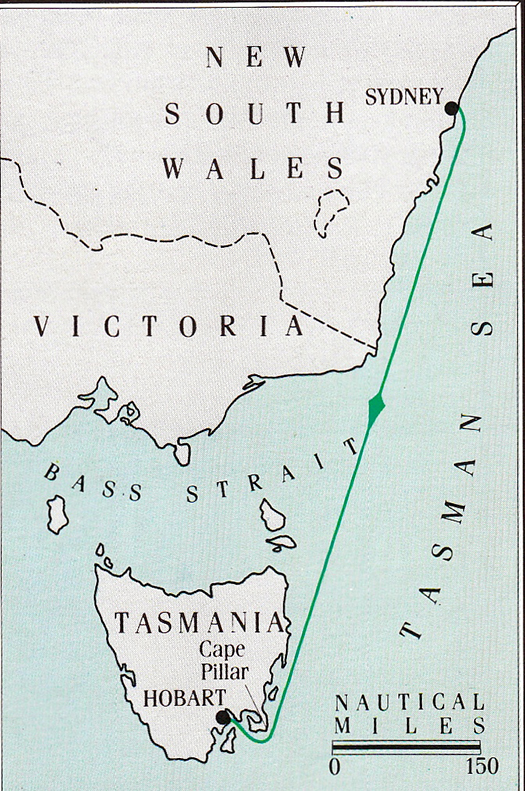
The great race's 628 mile course takes the competitors ever deeper towards the Southern Ocean with every mile sailed.
Of course there's Irish involvement in it at a specific level, with two boats in particular carrying our special interest. But at a more generous level, anyone who has the slightest interest in sailing cannot but be fired up by the wonder of an event in which some of the most advanced hundred footers in the world are swept up in a contest in which they will not only be in cut-throat competition with each other for line honours, but at the end, when all the calculations have been done, for dyed-in-the-wool offshore racing enthusiasts the real competition will be for the Tattersall's Cup, the hugely prestigious trophy for the overall handicap winner.
With 117 expected starters of all sizes from 33ft to 100ft, as the race gets under way each boat will have its own ideal set of conditions and circumstances to suit crew hopes. But as the contest continues, there'll be those who start to emerge in the leading group on handicap, and by the time they're in the final approaches, it is usually whittled down to about a dozen boats or even less which are in there with a shout for the Tattersall's.
But the line honours race for the Illingworth Cup – named in honour of the great British offshore racing skipper and innovator John Illingworth who first suggested the race in 1945 and won it too – now that's a different animal altogether. It's a real death or glory battle. And there's something specially entertaining and attractive about a no-holds-barred contest between boats you could like a lot, just at the time when the word is that the current flotilla of Volvo Round the World Racers may not be very likeable boats at all.
For we hear that the Volvo 65s are twitchy beasts, and not really fun to sail. To have a boat which turns round and looks at you is unfortunate. To have a boat which lies on its back and waves its legs in the air is unfortunate. But a boat that does both....? Oscar Wilde's Lady Bracknell said everything about such a situation.
So we'll return with relief to the crazy guys with the glorious big boats at the front of the fleet in the race to Hobart, for after the Volvo 65s, they're like a breath of fresh air. This is definitely not the territory of careful accountants and penny-pinching save-a-dime boatbuilding. We're looking at the stuff of legend. And the people's favourite has to be the veteran Wild Oats XI, marvellously campaigned by Mark Richards and his team of all the talents with the full support of the veteran owner Bob Oatley (86), whose wine brand of Wild Oats – one of many business interests – doesn't suffer any image problems at all when his boat of the same name wins yet again.
They talk of the Reichel Pugh designed super-slim Wild Oats XI as a "beloved old boat", but in truth she has been so continuously modified that you'd be hard put to say just what is original. The word is they've made her waterlines even narrower up forward – she used to be skinny, but now she's anorexic. As for last year's secret ingredient, the horizontal hydrofoil which, when deployed to lee, reportedly improved performance by up to 4% by making the boat better able to carry sail, for this year's race they tried making it even longer, such that it didn't entirely retract into the housing. But it seems that with a bit sticking out permanently on the weather side, it created more fuss than it was worth, so it has been shortened back to disappear entirely when not in use.
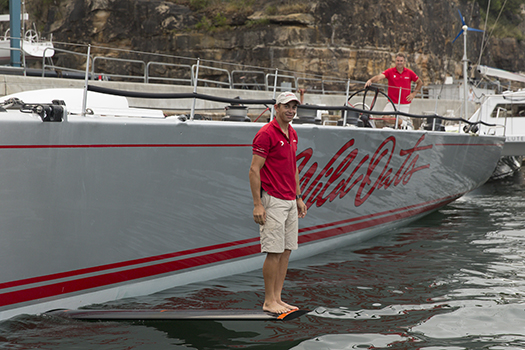
Wild Oats XI has so many bits and pieces sticking out of her hull that she has been compared to a Swiss Army Knife. This is skipper Mark Richards standing on the horizontal hydrofoil which, when deployed on the lee side, gives sufficient lift to significantly improve sail-carrying power. However, it has been shown that it has to be completely retractable into its housing when on the weather side, otherwise it causes unacceptable turbulence.
This conclusion on the downside of making the hydrofoil even longer emerged from some serious heavy weather sailing by Wild Oats off Sydney recently, when she was getting her final pre-Hobart race test and crew training. Heading back to port, with only about a quarter of the mainsail set in a very big wind, the silver arrow was making up to 33 knots. That will be food for thought for the four other hundred footers, the most challenging of which is of course Jim and Kristy Hinze Clark's new Comanche, just out of the wrappings, a hundred foot of total racer with Kenny Read as skipper.
The new girl on the block. American Jim Clark and his Australian wife Kristy Hinze Clark will debut their new hundred footer Comanche in the Rolex Sydney-Hobart 2014.
The same Kenny Read endeared himself to the Irish sailing community during the first Volvo visit to Galway five years ago, when he exited the dock somehow managing to look cool wearing a Paddy Hat that no-one else would be seen dead in. The boy is still busy, as he's worldwide president of North Sails, while his current main commitment afloat is to campaign the very extreme Comanche to the limit, with the Rolex-Sydney Hobart Race 2014 the first outing for real.

God be with the days.....five years ago, Kenny Read endeared himself to the people of Ireland by managing to look cool in this hat while exiting Galway Docks during the Volvo stopover. Photo: Failte Ireland/David Branigan
The hundred footers did have their first encounter a couple of weeks ago with the CYCA Solas Big Boat Challenge in Sydney Harbour, but racing boats this size in such relatively restricted water gives a somewhat skewed picture. Nevertheless the very experienced tacticians on Wild Oats still managed to finish first, as they did last year, but it was Comanche second quite a bit clear of Anthony Bell's Perpetual Loyal.
Once upon a time, Perpetual Loyal was very well known in Ireland, but that was in 2011 when she was George David's Rambler 100, and upside-down off West Cork. Until Comanche's appearance, Perpetual Loyal was reckoned the potentially fastest hundred footer of them all if she just could get enough wind in the right direction. But now the hundred footer field is wide open as a number of them have been undergoing major modifications of the kind you might expect to see on model yachts, but not on thirty metre hulls.

Can you see the join? The entire aft half of Rio 100 is entirely new, thanks to several months of major surgery in Auckland.
Thus the former Lahana, now American-registered, owned by Manouch Moshayedi and re-named Rio 100, simply had her entre aft half cut off, and replaced with a new wider stern section. Just like that. But you ain't heard nuthin' yet. The irrepressible Syd Fischer, shaping up to do his 50th Sydney-Hobart at the age of 87, decided that the hull of his hundred foot Ragamuffin needed some mods. A lot of mods. So he has just kept the deck and rig, but cut off the original hull, and replaced it with a new one from the same designer, Andy Dovell.
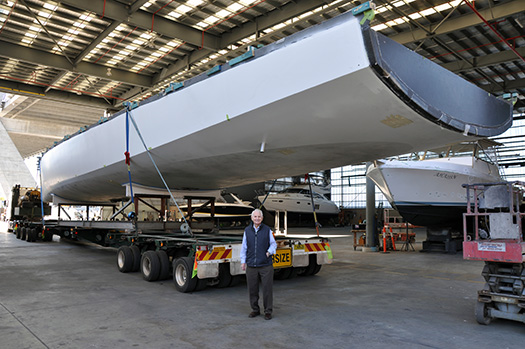
The incredible Syd Fischer, a sprightly 87-years-old, with the entirely new Andy Dovell-designed hull before it was fitted under the deck and rig of his previous hundred footer Ragamuffin.
So if next time you're on Sydney Harbour and a peculiar-looking hundred foot motorboat comes tootling past with a slightly lost air to her, you'll know why. She could swear that once upon a time she had a deep keel and a great big mast. But she's out and motoring about because there's no way Australians will let a redundant hundred foot hull go to waste. Meanwhile, the new raceboat hull has barely had time for testing, but we're assured all will be well, and the something old, something new Ragamuffin 100 will be there on the line raring to go against Wild Oats, Comanche, Perpetual Loyal and Rio 100 in the battle for line honours.
But as old Hobart hands will tell you, the real race is almost something else altogether. You'll have noticed that in mentioning the Solas Big Boat Challenge, we only talked of line honours. But it has an equally important IRC element as well, and two weeks ago the winner was Matt Allen's Carkeek 60 Ichi Ban, with Gordon Maguire the main man.

She may seem a plump girl by comparison with some other boats, but Matt Allen's Carkeek 60 Ichi Ban has been winning races, including the Solas Big Boat Challenge 2014. For the Rolex Sydney-Hobart 2014, skipper Gordon Maguire will be joined by ace Irish-born navigator Adrienne Cahalan.
And Ichi Ban's challenge in the Hobart race is even more Irish, as the Allen-Maguire team have linked up with Offaly-born Adrienne Cahalan to be navigator. One of Australia's top women sailors in almost any role, her navigational skills are legendary, and in the 2013 race she was navigating the 55ft Wedgetail to such good effect approaching the Tasmanian coast that they held the IRC lead, only for it all to come tumbling about their ears with a dismasting, which is hardly the navigator's fault.
So this time to Hobart, Ichi Ban really does have the dream team aboard. And though we still wonder if she's not just a little too plump in her waterlines forward to have that real cutting edge, the boat's results over the past year suggest that she has what it takes, and if the cards fall her way at all, she'll be clear to win.
Looking again at the top ten IRC boats in 2013, it's significant that apart from the freak presence of the hefty Swan 82 Nikata at 7th overall, only Ichi Ban at 8th overall was over 50ft long. The rest of the top ten were all 50ft or under, and the outstanding design was the evergreen Cookson 50, represented by both the overall winner Victoire (Darryl Hodgkinson), and the ninth placed Pretty Fly III (Colin Woods).
We in Ireland know well of the New Zealand-built Farr Cookson 50's brilliance through Chieftain (Ger O'Rourke), which later became Adrian Lee's Lee Overlay Partners, thus putting the Fastnet overall win of 2007 and the Caribbean 600 overall win of 2009 on the Cookson 50 winner-board before Victoire added the Sydney-Hobart win in 2013. It's some going for a design which first saw the light of day more than ten years ago.
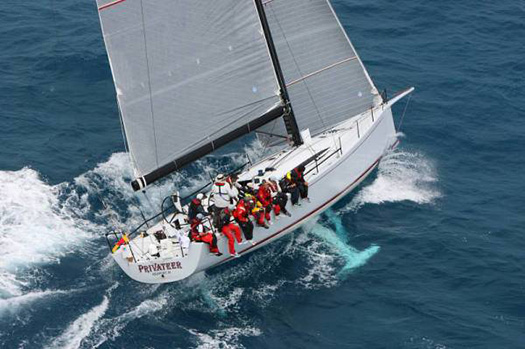
Privateer is one of the evergreen Cookson 50s, which have been consistently successful in the world's top offshore races for a decade
But as 2013's results show, doing well in the Sydney-Hobart has a huge element of horses for courses to it, and in 2010 the very new First 40 from Beneteau made a prodigious debut by taking first and second overall. They're still a very competitive boat, so not surprisingly there's five of them shaping up for the race to Hobart, and this is where the most direct Irish involvement comes, as Barry Hurley and his team have linked up with co-owner Mathew Vadas to put the beef in the crew of the First 40 Breakthrough. [Click to read Barry Hurley's preparations for this third successive Sydney–Hobart Race – Ed]
The same linkup saw Breakthrough take eighth in Class and 29th Overall in the 2013 race, but this time round Barry Hurley ships on board with the added experience of second overall and first in class in October's Middle Sea Race. With him to show that the boat is indeed sailing under the Dublin Bay Sailing Club colours are Catherine Halpin and Kenny and Alexander Rumball. And the word on the waterfront is that a shore support team not entirely unconnected with the Irish National Sailing School will be an enthusiastic presence in Sydney on December 26th. We look forward to hearing from them. Meanwhile, Happy Christmas everyone.
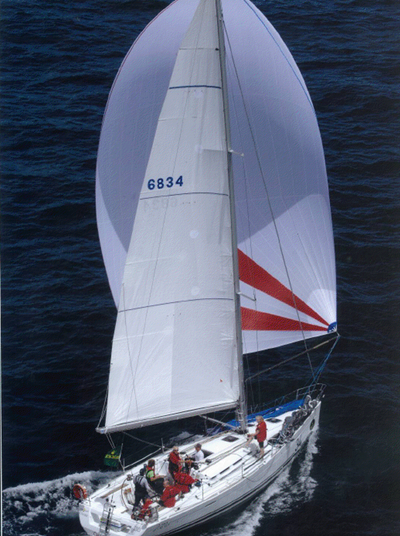
The First 40 Breakthrough will be racing under Dublin Bay Sailing Club colours in the Rolex Sydney-Hobart race 2014, starting December 26th
Wild Oats XI Sweeps the Board in Race to Hobart
#sydneyhobart – Wild Oats is currently sweeping the board in the Sydney-Hobart race taking line honours for a record sixth time and setting a new record (by 16 minutes) and also leads on corrected time with Loki (now finished ) lying second overall.
This morning, Wild Oats XI once again stamped her name in the Rolex Sydney Hobart history books. From the moment the start gun fired on Boxing Day the silver wraith seemed intent on condemning her rivals for line honours to the position of also-rans. Wild Oats XI's finish time of 1 day 18 hours 23 minutes and 12 seconds sliced 16 minutes 58 seconds off her own record. Another commanding performance in a race she has begun to treat as her own.
Without doubt skipper Mark Richard's crew of thoroughbred racers had some luck, but their race was not without problems. The first night saw the wind drop in the scheduled transition and her opponents close down the lead she had worked to establish during the afternoon. The crew held their nerve and once the northeasterly settled in they were off.
Ragamuffin-Loyal's endeavours to stay in touch with Wild Oats XI were hampered by a headsail gear failure from which the 100-foot maxi never recovered; Syd Fischer's equally accomplished crew forced to accept the unwelcome role of bridesmaid. Ragamuffin-Loyal finished almost five hours behind Wild Oats XI. Had the apparent error of starting the race too early been converted to a penalty, her crew's sense of disappointment would have been complete. Fortunately, the International Jury found that race officials failed to notify Ragamuffin-Loyal after five minutes that they had jumped the start, leaving the crew unaware that they should have returned and restarted.
By 20:30 AEDT only four yachts had completed the 628 nm course. Lahana rounded out the maxi contingent just before 19:00, while Black Jack was the first mini maxi some 40 minutes later. Loki and Ichi Ban will be next home. None have so far been capable of posting a time that knocks Wild Oats XI off the overall podium position. The door may be open for a smaller yacht if the weather obliges. Calm, Jazz, Quest and Shogun look best placed to foil a second triple crown. They need the wind to shift substantially in their favour, something it has singularly failed to do so far.
Irish Interest High at the Front of Sydney-Hobart Fleet
#Sydney Hobart update – Irish interest is strongly on the front of the fleet in the 68th Rolex Sydney Hobart Race, with Bob Oatley's 100ft Wild Oats – navigated by Australian-Irish Adrienne Cahalan – comfortably on course for line honours, and challenging for a new record to beat the existing one the Oakley boat set in 2005.
The defending handicap champion, the 63ft Loki (Stephen Ainsworth), with Howth's Gordon Maguire as Sailing Master, is currently lying second on corrected time. Loki has had a great race, and is currently fifth on the water with many larger boats astern.
But the 66ft canting keel Reichel Pugh 66 Black Jack (Peter Harburg) is going even better. The Black Jack team have targeted Loki as the boat to beat, and the two boats came out of Sydney Harbour at the start glued together. However, the slightly larger and higher-rated Black Jack – whose crew has recently been boosted by the addition of Australia's rising superstar sailor Tom Slingsby – gradually opened out a slight lead, and as conditions favoured those who could get south the quickest into more suitable winds, the Harburg boat was able to lengthen away enough to be saving their time as they approach Tasmania.
Day 2 of the 2012 Rolex Sydney Hobart has so far played out as predicted. The largest yachts have profited hugely from the overnight swing in wind direction to the northeast; one yacht in particular. At 17:30AEDT five-time Rolex Sydney Hobart line honours winner, Wild Oats XI, lay about 40 nautical miles ahead of her own record pace as she closed on Tasmania. In the process, she has brutally exposed the shortcomings of her competitors in straight-line speed sailing, even drawing out a 50nm lead over fellow maxi Ragamuffin Loyal.
Wild Oats XI appears on the cusp of a remarkable repeat of her 2005 triple-crown success: first boat home, new course record and overall win. Well in front of her rivals and the record on the water, all day long she has been trading the top handicap position with Peter Harburg’s Black Jack, according to the Cruising Yacht Club of Australia’s position tracker. Harburg has his own history making in mind: to become the first yacht from Queensland to lift the Tattersalls’ Cup. He will not be getting over-excited. This being a yacht race, the organizers are a long way from inscribing names onto silverware.
Wild Oats XI’s dream run will come to an end as the second weather transition kicks in during the night. The wind is forecast to die and to gradually back to the west, before steadily building into an, at times, strong southwesterly. The timing of this change, and the ability of skipper Mark Richards’ tactical team to get though it with minimum disruption, will determine the eventual outcome. Wild Oats XI must finish before 07:40 AEDT tomorrow to break the record of one day, 18 hours, 40 minutes and 10 seconds.Wild Oats XI, leading the fleet
For the smaller yachts yet to enter Bass Strait, the northeasterly looks likely to hang in until around midnight on 27 December. From then on the expected series of fronts moving through the Strait and across Tasmania will dramatically affect progress; buffeting the fleet north and south of island’s land mass, and at other times beguiling it with lighter, more fickle breeze, particularly in its lee.




























